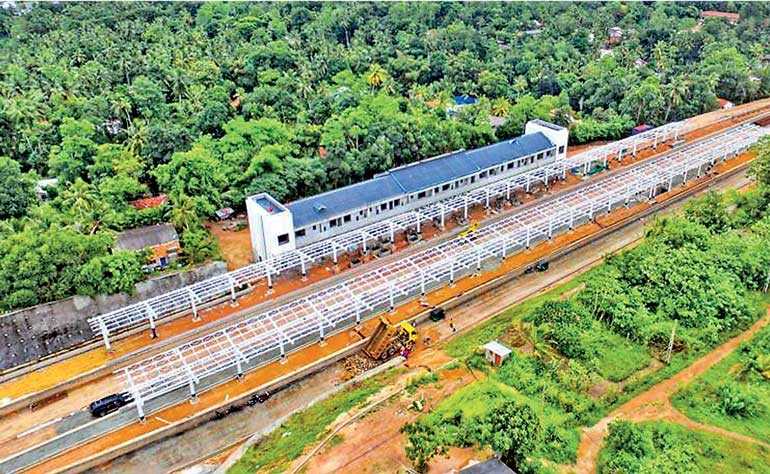Thursday Feb 27, 2025
Thursday Feb 27, 2025
Friday, 24 May 2019 00:00 - - {{hitsCtrl.values.hits}}

Who built the seven gates of Thebes?
The books are filled with names of kings.
Was it the kings who hauled the craggy blocks of stone?
And Babylon, so many times destroyed.
Who built the city up each time? In which of Lima’s houses,
That city glittering with gold, lived those who built it?
In the evening when the Chinese wall was finished
Where did the masons go? Imperial Rome
Is full of arcs of triumph. Who reared them up? Over whom
Did the Caesars triumph? Byzantium lives in song.
Were all her dwellings palaces? And even in Atlantis of the legend
The night the seas rushed in,
The drowning men still bellowed for their slaves.
Young Alexander conquered India.
He alone?
Caesar beat the Gauls.
Was there not even a cook in his army?
Phillip of Spain wept as his fleet
was sunk and destroyed. Were there no other tears?
Frederick the Great triumphed in the Seven Years War.
Who triumphed with him?
Each page a victory
At whose expense the victory ball?
Every ten years a great man,
Who paid the piper?
So many particulars.
So many questions
– A Worker Reads History- Bertolt Brecht (1898-1956)
In 2019, after 70 long years of independence, Sri Lanka succeeded in adding to the rail network left behind by the British when we extended the southern line from Matara to Beliatta, a distance of less than 20 miles. While the network left in place by the Colonial Government remained more or less static, the period in between saw no improvement, on the contrary, our railway service in comparison with other countries, has only deteriorated and decayed.
During what are commonly referred to as the southern insurrections (app. 1971 and 1985/’89) extensive damage was caused to railway properties including carriages, stations and equipment by the insurgents.
Much more systematic and thorough going destruction was wrought during the protracted insurgency unleashed by the LTTE which followed (app. 1983-2009). They effectively uprooted the popular northern rail line, including its metal tracks.
In addition to these violent body blows, our railway service also suffers badly the common ills of the public sector; large under-utilised assets providing a service which is indifferent, inefficient and ineffective, and needs to be subsidised all the way.
In the busy hours jam-packed, non-peak hours too many empty trains and only the odd train that runs on time would describe a day at the railways. Last week a friend related to me his experience in the buffet car of the Kandy train; a bun wrapped in a torn page of a newspaper and an undrinkable tea in a cup with a loose handle! He didn’t want recall his visit to the train toilet, a nightmare experience that he will only block from his memory.
Ground level realities do not faze our public sector bureaucrats, eager to win points with the politicians. Not to be left behind, our railway service has joined in the national hype to lure the tourists, with designated trains/carriages carrying names reminiscent of the colonial era.
I am told the service on these special tourist trains is superior to the rundown passenger trains, so long as the tourist hasn’t got to answer a call of nature. It is said sometimes that you can assess the efficacy of a culture from the cleanliness of its public toilets. Times have moved on, there are many more travellers now, with vastly different expectations from travel; a mere adoption of a colonial era name will neither give life to a fantasy, nor improve a shoddy reality.
Predictably, the short extension of the rail track from Matara to Beliatta was celebrated as a major achievement. Several high ranking politicians, political operatives and bureaucrats, including the Minister of Transport, travelled in long convoys of plush vehicles to Matara for the ceremony. In addition to the auspicious times, our public ceremonies are heavy on symbolism.
Usually, after prolonged formalities, the Chief Guest will ‘symbolically’ cut the first soil, open a tap or even feed a piece of milk rice with his hand to signify a beginning. In this instance, the Minister launched the extended railway or as is commonly professed “handed over the train service to the people,” by travelling on the inaugural train journey to Beliatta, where he presumably was picked up by his awaiting convoy.
The ceremony did not go smoothly, there were some vociferous protesters at the scene objecting to the composition of the VIP passenger group. They claimed that the guests were imposters and that the honour for the extension should go to the previous Government, particularly the former President Mahinda Rajapaksa who hails from that area.
It must be noted that Arjuna Ranatunga, who is the present Minister responsible for Transport, did not in any way claim ownership for the project and was present at the ceremony only as the subject minister. In fact, he has held the portfolio only for a few months now.
But who can claim sole responsibility for a relatively large project such as this? We do not have the historical documents to answer the question adequately, nor are we inclined to devote the time necessary to investigate a matter, an undertaking bound to be long and convoluted. Their accuracy and objectiveness apart, when it comes to even basic record keeping, Sri Lanka certainly is not a shining star.
Going by other similar undertakings, we can assume with confidence that this project would have had an extended gestation period, made longer by the unhurried pace of our public sector. In the densely-populated Southern Province, obtaining the land for the track alone would have involved interminable negotiations and arrangements. Once the land is finalised there is the surveying and the soil testing for suitability; the track needs to be strengthened, bridges built and tunnels made.
In Sri Lanka, nearly all big projects are funded with either foreign aid or borrowings. Such sources are not the readiest creditors, requiring several, feasibility, environmental and other studies. At long last when the money is found and the land allocated, there is the actual construction of the line. A host of professionals: engineers, surveyors, specialists in railway construction and so on need to come together to make it happen. Many Government departments are involved, work has to be planned and allocated, tenders called for, contracts awarded.
For the general public, this credit list is far too long and difficult to grapple with. They need a simple explanation for complex and nuanced processes. It is easier to identify a project with one public figure than to search for all its authors, to declare one hero than to find the heroism of hundreds. Why not identify the whole thing with the most visible – the politician on top?
As a result, in this little country we have invented leaders who have led global movements, designed and constructed massive projects and fought ferocious wars single -handed. But imagination is not reality. The truth is more banal; our hero is perhaps only a beneficiary of the whole scheme, being at the right place at the right time, he is celebrated as a conquering hero.
Apart from the undeserved plaudits, our public life is notorious for its bribes, kickbacks and commissions. These have become so common they are now taken as due returns. And while he is at it, only the family members who get the plum jobs in his ministry, further extending the benefits from his ‘elected’ office. In monetary as well as social terms, the guy and his relatives end up richer than ever imagined. Catching on to the secret, soon his brats follow ‘appachchi’ into politics, keeping up the family tradition of ‘service’.
Despite all this sound and fury, around us is a country in agony, caught in a trap of material as well as mental poverty, unable to breakout, remarkable only for its sure mediocrity.
The question that rises out of the uninspiring protests at the Matara Railway Station goes to the root of our political culture.
Who built the Matara-Beliatta railway extension?
Discover Kapruka, the leading online shopping platform in Sri Lanka, where you can conveniently send Gifts and Flowers to your loved ones for any event including Valentine ’s Day. Explore a wide range of popular Shopping Categories on Kapruka, including Toys, Groceries, Electronics, Birthday Cakes, Fruits, Chocolates, Flower Bouquets, Clothing, Watches, Lingerie, Gift Sets and Jewellery. Also if you’re interested in selling with Kapruka, Partner Central by Kapruka is the best solution to start with. Moreover, through Kapruka Global Shop, you can also enjoy the convenience of purchasing products from renowned platforms like Amazon and eBay and have them delivered to Sri Lanka.
Discover Kapruka, the leading online shopping platform in Sri Lanka, where you can conveniently send Gifts and Flowers to your loved ones for any event including Valentine ’s Day. Explore a wide range of popular Shopping Categories on Kapruka, including Toys, Groceries, Electronics, Birthday Cakes, Fruits, Chocolates, Flower Bouquets, Clothing, Watches, Lingerie, Gift Sets and Jewellery. Also if you’re interested in selling with Kapruka, Partner Central by Kapruka is the best solution to start with. Moreover, through Kapruka Global Shop, you can also enjoy the convenience of purchasing products from renowned platforms like Amazon and eBay and have them delivered to Sri Lanka.